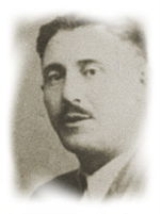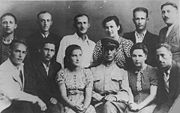
Leon Feldhandler
Encyclopedia
Leon Feldhendler (1910 – 6 April 1945), was a Polish-Jewish
resistance fighter known for his role in organizing, with Alexander Pechersky
, the 1943 prisoner uprising at the Sobibor extermination camp
. Prior to his deportation to Sobibor, Feldhendler had been head of the Judenrat
(Ger. "Jewish Council") in his village of Żółkiewka, Lublin Voivodeship, in German-occupied Poland.
of the camp perimeter by the SS in the summer of 1943 rendered the plan impractical.
 The arrival in a transport of Soviet POWs of Red Army
The arrival in a transport of Soviet POWs of Red Army
officer
Alexander Pechersky
in late September gave new impetus to the escape plans. A seasoned soldier, Pechersky soon assumed the leadership of the group of would-be escapees and, with Feldhendler as his deputy, the group formed a plan that involved killing the camp's SS personnel, sending the Soviet POWs to raid the arsenal
and then fighting their way out the camp's front gate.
The uprising, which took place on October 14, 1943, was detected in its early stages after a guard discovered the body of an SS officer killed by the prisoners. Nevertheless, about 320 Jews managed to make it outside of the camp in the ensuing melee. Eighty were killed in the escape and immediate aftermath. 170 were soon recaptured and killed, as were all the remaining inhabitants of the camp who had chosen to stay. Some escapees joined the partisans
. Of these, ninety died in combat or were killed by local collaborators or anti-Semites. Sixty-two Jews from Sobibor survived the war, including nine who had escaped earlier.
until the end of German occupation in July 1944. However, on April 2, 1945, he was shot through the closed door of his flat as he got up to investigate a commotion in an outer room. Feldhendler and his wife managed to escape through another door and made their way to Lublin's Św. Wincentego á Paulo hospital, where he underwent surgery but died four days later. According to most of the older publications, Feldhendler was killed by right-wing Polish nationalists
, sometimes identified as the Narodowe Siły Zbrojne, an anti-Communist and anti-Semitic paramilitary
organization which formed part of the Polish resistance
. However, at least one recent paper, citing the incomplete treatment of the event by earlier historians and the scant documentary record, has called into question this version of events. Feldhendler's killing was one of at least 118 murders of Jews in the Lublin district between the summer of 1944 and the fall of 1946.
he was played by Alan Arkin
. The final period of his life in Lublin is described in the 2005 novel Wyjątkowo długa linia by Hanna Krall
which was nominated for the Nike Award
.
History of the Jews in Poland
The history of the Jews in Poland dates back over a millennium. For centuries, Poland was home to the largest and most significant Jewish community in the world. Poland was the centre of Jewish culture thanks to a long period of statutory religious tolerance and social autonomy. This ended with the...
resistance fighter known for his role in organizing, with Alexander Pechersky
Alexander Pechersky
Alexander Aronovich Pechersky was the chief organizer and leader of the most successful uprising and mass-escape of Jews from a Nazi extermination camp during World War II; this occurred at the Sobibor extermination camp on 14 October 1943.-Early life:...
, the 1943 prisoner uprising at the Sobibor extermination camp
Sobibór extermination camp
Sobibor was a Nazi German extermination camp located on the outskirts of the town of Sobibór, Lublin Voivodeship of occupied Poland as part of Operation Reinhard; the official German name was SS-Sonderkommando Sobibor...
. Prior to his deportation to Sobibor, Feldhendler had been head of the Judenrat
Judenrat
Judenräte were administrative bodies during the Second World War that the Germans required Jews to form in the German occupied territory of Poland, and later in the occupied territories of the Soviet Union It is the overall term for the enforcement bodies established by the Nazi occupiers to...
(Ger. "Jewish Council") in his village of Żółkiewka, Lublin Voivodeship, in German-occupied Poland.
Role in Sobibor Uprising
In the spring of 1943, Feldhendler led a small group of Sobibor prisoners formulating an escape plan. Their initial plan had been to poison camp guards and seize their weapons, but the SS discovered the poison and shot five Jews in retaliation. Other plans included setting the camp on fire and escaping in the resulting confusion, but the miningAnti-personnel mine
Anti-personnel mines are a form of land mine designed for use against humans, as opposed to anti-tank mines, which are designed for use against vehicles...
of the camp perimeter by the SS in the summer of 1943 rendered the plan impractical.

Red Army
The Workers' and Peasants' Red Army started out as the Soviet Union's revolutionary communist combat groups during the Russian Civil War of 1918-1922. It grew into the national army of the Soviet Union. By the 1930s the Red Army was among the largest armies in history.The "Red Army" name refers to...
officer
Officer (armed forces)
An officer is a member of an armed force or uniformed service who holds a position of authority. Commissioned officers derive authority directly from a sovereign power and, as such, hold a commission charging them with the duties and responsibilities of a specific office or position...
Alexander Pechersky
Alexander Pechersky
Alexander Aronovich Pechersky was the chief organizer and leader of the most successful uprising and mass-escape of Jews from a Nazi extermination camp during World War II; this occurred at the Sobibor extermination camp on 14 October 1943.-Early life:...
in late September gave new impetus to the escape plans. A seasoned soldier, Pechersky soon assumed the leadership of the group of would-be escapees and, with Feldhendler as his deputy, the group formed a plan that involved killing the camp's SS personnel, sending the Soviet POWs to raid the arsenal
Arsenal
An arsenal is a place where arms and ammunition are made, maintained and repaired, stored, issued to authorized users, or any combination of those...
and then fighting their way out the camp's front gate.
The uprising, which took place on October 14, 1943, was detected in its early stages after a guard discovered the body of an SS officer killed by the prisoners. Nevertheless, about 320 Jews managed to make it outside of the camp in the ensuing melee. Eighty were killed in the escape and immediate aftermath. 170 were soon recaptured and killed, as were all the remaining inhabitants of the camp who had chosen to stay. Some escapees joined the partisans
Leśni
Leśni is one of the informal names applied to the anti-German partisan groups operating in occupied Poland during World War II. The groups were formed mostly by people who for various reasons could not operate from settlements they lived in and had to retreat to the forests...
. Of these, ninety died in combat or were killed by local collaborators or anti-Semites. Sixty-two Jews from Sobibor survived the war, including nine who had escaped earlier.
Murdered in Lublin
Feldhendler was among those who survived the war, hiding in LublinLublin
Lublin is the ninth largest city in Poland. It is the capital of Lublin Voivodeship with a population of 350,392 . Lublin is also the largest Polish city east of the Vistula river...
until the end of German occupation in July 1944. However, on April 2, 1945, he was shot through the closed door of his flat as he got up to investigate a commotion in an outer room. Feldhendler and his wife managed to escape through another door and made their way to Lublin's Św. Wincentego á Paulo hospital, where he underwent surgery but died four days later. According to most of the older publications, Feldhendler was killed by right-wing Polish nationalists
Nationalism
Nationalism is a political ideology that involves a strong identification of a group of individuals with a political entity defined in national terms, i.e. a nation. In the 'modernist' image of the nation, it is nationalism that creates national identity. There are various definitions for what...
, sometimes identified as the Narodowe Siły Zbrojne, an anti-Communist and anti-Semitic paramilitary
Paramilitary
A paramilitary is a force whose function and organization are similar to those of a professional military, but which is not considered part of a state's formal armed forces....
organization which formed part of the Polish resistance
Polish resistance movement in World War II
The Polish resistance movement in World War II, with the Home Army at its forefront, was the largest underground resistance in all of Nazi-occupied Europe, covering both German and Soviet zones of occupation. The Polish defence against the Nazi occupation was an important part of the European...
. However, at least one recent paper, citing the incomplete treatment of the event by earlier historians and the scant documentary record, has called into question this version of events. Feldhendler's killing was one of at least 118 murders of Jews in the Lublin district between the summer of 1944 and the fall of 1946.
Feldhendler in culture
In the 1987 made-for-TV film Escape from SobiborEscape from Sobibor
Escape from Sobibor is a 1987 British made-for-TV film which aired on CBS. It deals with the extermination camp at Sobibor, the site of the most successful uprising by Jewish prisoners of German extermination camps...
he was played by Alan Arkin
Alan Arkin
Alan Wolf Arkin is an American actor, director, musician and singer. He is known for starring in such films as Wait Until Dark, The Russians Are Coming, the Russians Are Coming, The Heart is a Lonely Hunter, Catch-22, The In-Laws, Edward Scissorhands, Glengarry Glen Ross, Marley & Me, and...
. The final period of his life in Lublin is described in the 2005 novel Wyjątkowo długa linia by Hanna Krall
Hanna Krall
Hanna Krall is a Polish writer.-Childhood:Krall is of Jewish origin. During World War II she lost some of her close relatives. She survived the war only because she was hidden from the Nazis.-Journalism:...
which was nominated for the Nike Award
Nike Award
The NIKE Literary Award is one of the most prestigious awards for Polish literature. Established in 1997 and funded by Gazeta Wyborcza, Poland's second largest daily paper, and the consulting company NICOM, it is conferred annually in October for the best book of a single living author writing in...
.

